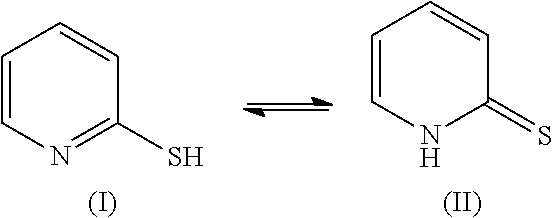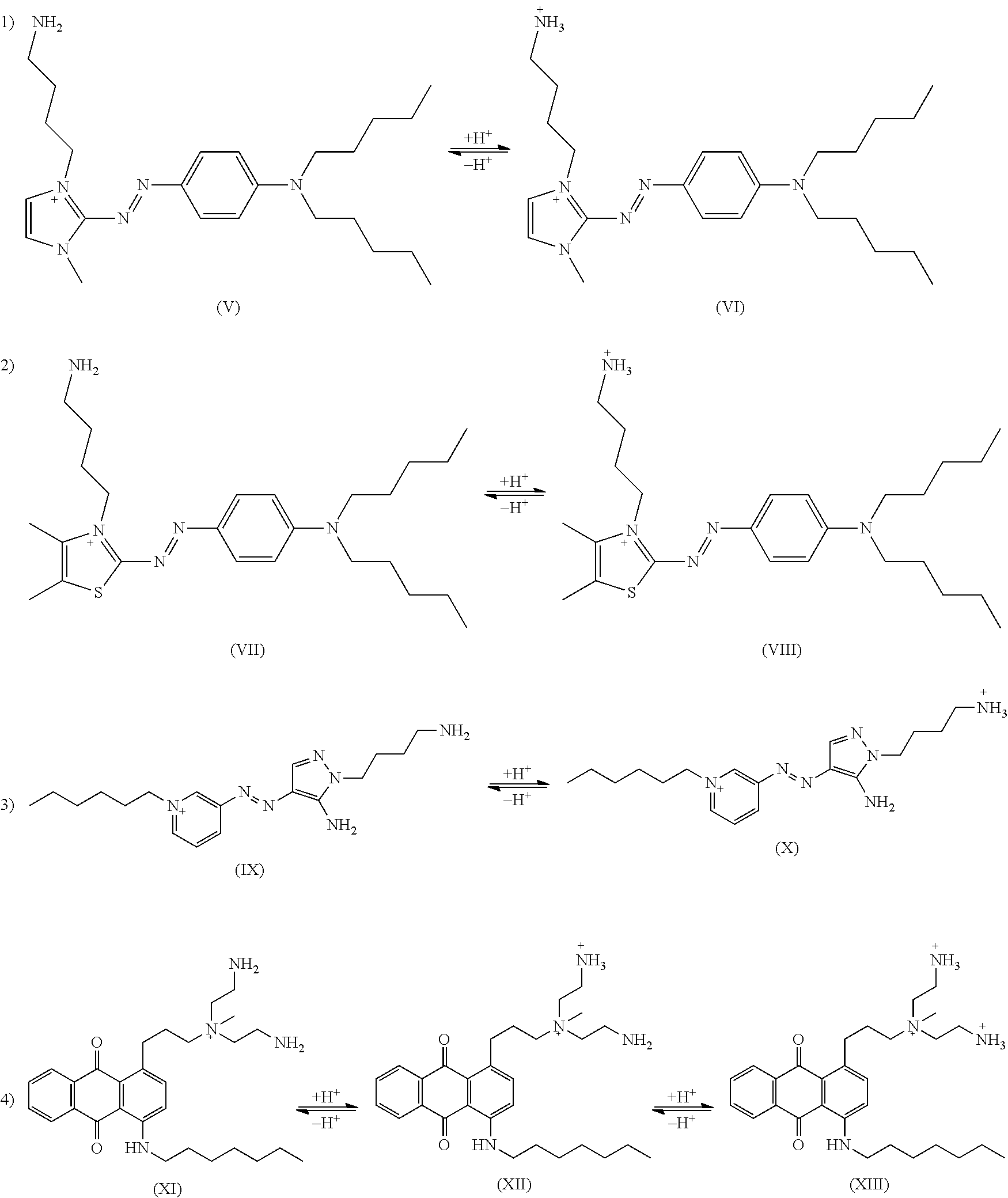Method of Coloring Hair with Direct Dye Compounds
a dye compound and dye technology, applied in the field of dye compound dyeing hair, can solve the problems of difficult to produce dark shades, difficulty in producing dark shades,
- Summary
- Abstract
- Description
- Claims
- Application Information
AI Technical Summary
Benefits of technology
Problems solved by technology
Method used
Image
Examples
example 1
[0158]In example 1, the permanent charge is part of the chromophore and resides on the imidazolium moiety. The incipient cations are linked to the chromophore via propylene groups. The hydrophobic moieties are two symmetrically substituted n-pentyl groups.
Method
[0159]2-((4-fluorophenyl)diazenyl)-1H-imidazole was alkylated with 1-bromopentane in acetonitrile with NaHCO3 as proton sponge. The dialkylated intermediate was then treated with diBoc protected dipropylenetriamine before the Boc group was removed with aq. HCl. The desired red dye was purified on preparative HPLC with C18 reverse phase column and water / acetonitrile (with 0.1% TFA) as mobile phase. The final product was collected as a trifluoroacetate salt.
[0160]1H NMR: (600.1 MHz, D2O) δ=0.60 (6 H, t, J=6.2 Hz), 1.06 (8 H, br), 1.58 (4 H, br), 1.98 (4 H, pentet, J=7.7 Hz), 3.03 (4 H, t, J=7.7 Hz), 3.55 (4 H, J=7.3 Hz), 4.12 (4 H, br), 6.78 (2 H, dd, J1=9.2 Hz, J2=2.2 Hz), 7.30 (2 H, d, J=2.0 Hz), 7.69 (2 H, dd, J1=9.0 Hz, J2=...
example 2
[0162]In example 2, the permanent charge is part of the chromophore and resides on the imidazolium moiety. The incipient cations are linked to the chromophore via propylene groups. The hydrophobic moieties are two symmetrically substituted n-pentyl groups.
Method
[0163]2-((4-fluorophenyl)diazenyl)-1H-imidazole was alkylated with N-(3-bromopropyl)phthalimide in acetonitrile with NaHCO3 as proton sponge. The dialkylated intermediate was then treated with dipentylamine after which the amino groups were deprotected with ethylenediamine The desired red dye was purified on preparative HPLC with C18 reverse phase column and water / acetonitrile (with 0.1% TFA) as mobile phase. The final product was collected as a trifluoroacetate salt.
[0164]1H NMR: (600.1 MHz, D2O) δ=0.69 (6 H, t, J=7.0 Hz), 1.13˜1.14 (8 H, m), 1.44 (4 H, br), 2.14 (4 H, pentet, J=7.6 Hz), 2.96 (4 H, t, J=8.0 Hz), 3.39 (4 H, J=7.7 Hz), 4.39 (4 H, t, J=7.1 Hz), 7.05 (2 H, d, J=8.5 Hz), 7.45 (2 H, s), 7.86 (2 H, d, J=9.1 Hz).
[01...
PUM
| Property | Measurement | Unit |
|---|---|---|
| color | aaaaa | aaaaa |
| hydrophobic | aaaaa | aaaaa |
| pH | aaaaa | aaaaa |
Abstract
Description
Claims
Application Information
 Login to View More
Login to View More - R&D
- Intellectual Property
- Life Sciences
- Materials
- Tech Scout
- Unparalleled Data Quality
- Higher Quality Content
- 60% Fewer Hallucinations
Browse by: Latest US Patents, China's latest patents, Technical Efficacy Thesaurus, Application Domain, Technology Topic, Popular Technical Reports.
© 2025 PatSnap. All rights reserved.Legal|Privacy policy|Modern Slavery Act Transparency Statement|Sitemap|About US| Contact US: help@patsnap.com



